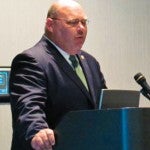Emergency leaders prepare for the worst
The recent tornado outbreak in Alabama was without question a historic event. But picture a disaster so widespread that it directly impacts everyone in the state — how could we be prepared?
Public health officials and others from across North and Central Alabama met Wednesday at the Alabama Power Conference Center in Clanton for just that reason.

State EMA Director Art Faulkner addresses people at a Strategic National Stockpile exercise in Clanton Wednesday.
The Strategic National Stockpile (SNS) is designed to quickly get medical supplies to the entire population in the event of a hurricane, flu pandemic, terrorist attack or other catastrophe similar in scale. Wednesday’s meeting was an SNS exercise to benefit public health officials, state and county EMA workers, law enforcement and other community leaders.
The exercise was sponsored by the Alabama Department of Public Health Center for Emergency Preparedness.
“SNS would only come into play during an extremely catastrophic disaster, such as an anthrax attack or a disease outbreak like smallpox,” said DeeAnn White, SNS coordinator with the Alabama Department of Public Health.
The SNS began in 1999 as the National Pharmaceutical Stockpile. As of March 2003, it was placed under joint management by the Centers for Disease Control and Prevention (CDC) and the Department of Homeland Security.
The SNS is a national repository of life-sustaining medicines and medical supplies. In the event of a large-scale disaster, pods would be set up in different areas of affected communities for rapid distribution to the public.
Chilton County EMA Director Bill Collum said the goal would be to supply 100 percent of the population within 48 hours.
“We understand this is an extreme scenario, but it’s our responsibility to be prepared for all of these contingencies,” Collum said.
Local emergency management agencies do not handle the supplies themselves, Collum indicated, but rather the logistics involved in delivering them to the public.
More than half of the 11 public health areas in Alabama were represented at Wednesday’s exercise, including Areas 1-6. The exercise was sponsored by the state Department of Public Health and conducted by Lee Helms & Associates.


